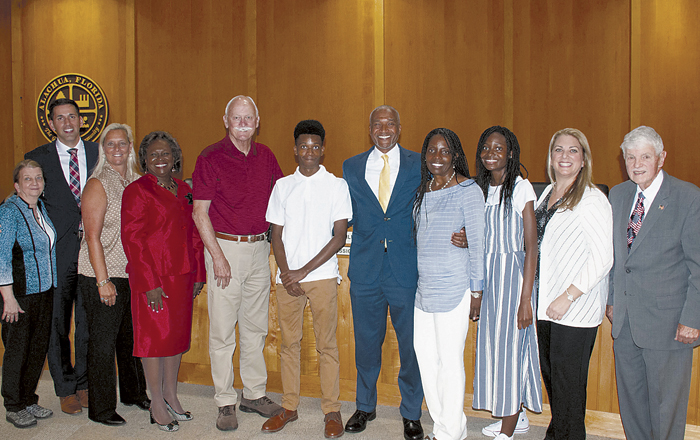HIGH SPRINGS ‒ Poe Springs Park is open again. And tubing, kayaking and barbecuing were just a few ways people spent their Memorial Day weekend at the park’s reopening. The park has endured a series of openings and closings over the past several years to accommodate various improvements and repairs to the facilities.
Poe is the largest spring in Alachua County and pumps 45 million gallons of water daily, offering swimming in the spring area, hiking along the trails, kayak and canoe launches and buildings for events.
A popular weekend recreation area, the property includes a playground, volleyball courts, sports fields and nature trails and includes pavilions and picnic shelters with bar-b-que grills. There is also a lodge building for event rentals, such as parties, family gatherings and small weddings.
Poe Springs has been a popular recreation area for almost 70 years. Poe was privately owned until 1985 when the initial 75 acres was purchased with a federal grant from the land and water conservation fund. Additional acreage was provided by Suwanee River Water Management District (SRWMD) and additional grant funds in the 1980s and in 1991, Alachua County opened the park to the public.
Alachua County shut the park in December 2011 for a construction project that included a new retaining wall and steps in the spring-fed swimming area, new landscaping and new roofs and air-conditioning units on the buildings and pavilions.
It reopened again on July 4, 2013 for four days a week with no admission charge under a barebones arrangement between the County and the City of High Springs. It closed again in 2017 due to damage from Hurricane Irma and opened again in May 2018 after repairs were made but on a shorter weekend only schedule of Friday to Sunday.
Then came the COVID 19 pandemic and the park closed again under state quarantine in March 2020 only to open again three months later. The springs portion of the park closed yet again three months later in September 2020 for renovations, but the boat ramp remained open. Although renovations were anticipated to be finished by January 2021, delays kept the park closed until this Memorial Day weekend.
Alachua County Open Spaces Manager Jason Maurer said he is glad to see the park reopened, especially as a recreation area for children. “We did a lot of inhouse projects, some concrete work, cleaning the building, and upgrading some of the facilities.”
Maurer also said improvements include fresh sand in the volleyball courts, new ADA compliant sidewalks and a heightened eight-foot-wide pathway leading to Poe Springs.
“We still have more improvements to make including a new boat ramp and improved nature paths,” said Maurer, “but the park is now improved to provide a better time for every one with more facilities available.”
According to Maurer, the new boardwalk at Poe Springs Park has been raised to avoid flood damage and he is expecting more finishing touches to be added including the completion of a second alternate boardwalk to the spring head. “We'll be adding educational signs and a historical marker of Hurricane Irma levels," Maurer said.
The park will now be open seven days a week 8 a.m. to 8 p.m. While the park had been free in the past, to help cover the cost of maintenance and increased staffing due to the seven-day schedule, now there is an entry fee of $6 per vehicle and $1 for visitors walking or biking.
The county has also added the services of Anderson's Outdoor Adventures (AOA), which not only rents kayaks, canoes and tubes, but will drop off and pick up boaters at various locations. AOA is the outfitter and food concessions contractor with other local springs including Manatee, Hart, Blue and Fanning Springs as well as the Santa Fe River Park. The company also has plans to bring in more food and concessions in the near future.
Pick-up and drop-off services for tube and watercraft will operate from 9:30 a.m. to 2:30 p.m. daily to and from the Highway 27 bridge. The trip itself is two to three hours floating from the drop off to the boat ramp at Poe Springs. There is a $9 rental fee for tubes that visitors can use to float in the springs or float down the river to the boat ramp and repeat that trip as many times as desired. Rental services for tubes and watercraft is open from 9:30 a.m. to 2:30 p.m.
Maurer said the park is still under Covid distancing regulations and is limited to 120 parking spaces at any time. “We had full capacity of 300 to 400 people all three days of the Memorial Day weekend. It was great to see everyone, especially the children, enjoying this unique park.”
Money for the boardwalk and other repairs was split, with $280,665 from the Federal Emergency Management Agency as hurricane compensation and $284,152 from the county’s Wild Spaces and Public Places tax.
The park is located at 28800 N.W. 182nd Avenue, High Springs on State Highway 236, which is also known as Poe Springs Road. For more information, contact the Alachua County Parks and Conservation Land Office at 352-264-6868 or parks@alachuacounty.us.
# # #
Email rcarson@
alachuatoday.com
Add a comment



